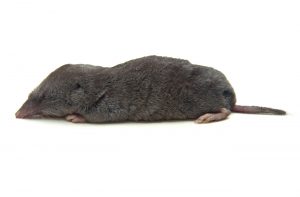DON’T TRY TAMING A SHREW!
By Chris Williams on February 12, 2018.
I caught my dog having a standoff in the garage with what I thought was a mouse. The thing kept charging at him, trying to bite him. The dog finally killed it so we got a look at it – short hairy tail, tiny eyes and ears, and pointy snout. It doesn’t match the description of a mouse, could it have been a young rat? W. S., Pepperell, MA
Your intruder doesn’t match a rat either if your description is accurate. Rats have a long, naked tail and their ears and eyes are prominent. It could be that your dog tangled with a shrew. Although shrews are rodent-like, they are not rodents but belong to the order Insectivora. Moles are also in this group because both feed on insects and other arthropods, as well as worms, snails, slugs. Shrews sometimes feed on young mice or birds, or snakes. Moles have large front digging claws which is a good way to separate them from shrews and rodents.
SHREWS ARE NASTY BUT BENEFICIAL
Shrews are small, only 3 to 5 inches long including their tail, but they can be very feisty and aggressive. They are active day and night, year round. People often first notice them when one of their pets is attacked. Shrews also attack birds at feeders and they can secrete a foul-smelling defensive odor from musk glands. They’re just not very lovable but they are considered to be beneficial because of their appetite for insects and slugs.

Northern short-tailed shrew
Shrews have a very pointed, hair-covered snout and sharp, pointy teeth. They have velvety fur that almost hides their tiny ears. Their eyes are very small, legs are short, and their tail has hair. Needless to say, shrews have poor eyesight but a well-developed sense of touch. They most often nest in the abandoned burrows of moles and voles.
In Massachusetts we have at least six different species of shrews, two of which occur statewide but are not often seen. One of them, the northern short-tailed shrew subdues its prey with paralyzing saliva. The other is the masked shrew which is the most widely distributed shrew in North America.
SHREWS ARE ACCIDENTAL AND TEMPORARY INTRUDERS
Shrews don’t live and breed in homes like mice, but in rare situations they can end up inside. That usually happens when a pet carries one inside or when a shrew accidentally gets into a garage or basement, sometimes when following insect prey inside. See Shrews Can Be Indoor Pests, But Rarely.
If you see anything rodent-like in your home, give Colonial Pest a call. We can develop a management plan no matter whether your unwanted visitors are mice, rats, or even shrews. By the way, squirrels are rodents, too, and we have a plan for them as well. Call Colonial!